‘Contractor’ in this Guideline is taken to mean any Limited company we contract to perform a given task or service for the �鶹��, but does not include wholly owned subsidiaries of the �鶹��, Independent Production Companies (see our other Guideline), freelancers (see our other Guideline) or contributors (see our other Guideline).
The purpose of this Guideline is to ensure that through adoption of the 4Cs (Communication, Co-ordination, Co-operation and Competence) we can achieve an appropriate degree of safety control in our work. This Guideline covers the safety management principles involved in all contractors we work with, whether used regularly , or those engaged for one-off jobs.
What Can go Wrong?
- Accident / incident arising out of failure to adopt the safety principles in any one of the 4Cs
- Legal proceedings taken against the �鶹�� or the contractor as a result of non-compliances arising out of failure to adopt the safety principles in any one of the 4Cs
- Reputational damage to the �鶹�� arising out of either of the two preceding points.
Legal/�鶹�� Requirements
- General duty of care to ensure that all significant safety risks to third parties arising out of our business are being suitably assessed and managed
- We have a duty to communicate clearly what it is that we want from a contractor, and then co-ordinate their activities with our own
- We have a duty to ensure that those we contract to carry out work on our behalf are competent and capable of doing the work safely
- We have a duty to monitor the work of contractors to ensure they are working to risk assessments / method statements / site safety rules / or any other safe system of work agreed to when contracted.
Control Measures
Defining the job
- Is a contractor the right option - ask yourself if suitable / appropriate to contract the work out to someone who may not be familiar with how the �鶹�� works; could it be done by someone in-house, for example, an in-house drone operator, safety training by another �鶹�� department, etc.
- Be clear about the job required - be prepared to clearly define what it is you want from a contractor and over what period of time; this will define the terms of the contract you have with them, and any possible liabilities which might arise should something go wrong or the service / task end up not being completed to your requirements / satisfaction.
- Sense check the scope of work – if you’re not an expert on the service / job required, you may want to speak to someone who is. This could be the contractor you are likely to appoint, but always sense check this with someone independent (e.g. work colleague, �鶹�� Safety, �鶹�� Insurance).
Selecting the right contractor
The key safety issues you must consider and verify when selecting an appropriate contractor will be:
- Competence – do they have the right qualifications, knowledge and experience to perform a good job for you? Some disciplines have specific legal requirements in terms of competence (e.g. pilots, Doctors, Structural Engineers, etc.), whereas others have what may be called ‘industry standard’ competency requirements defined by National (or International) Governing Bodies, Trade Associations or similar (e.g. cherry picker operators, Mountaineering Guides, electricians, etc.). Where we have them, our Safety Guidelines describe the competency requirements you should expect; where we don’t, either check them against the appropriate governing body or check with your Safety Advisor.
- Safety standards – in addition to any personal competence criteria, do they know and work to relevant safety standards for their discipline / industry? In addition to having safety policies and risk assessments, there may be further legal requirements (e.g. inspections of lifting equipment under LOLER, firearms certificates, licensed to display animals under the Dangerous Wild Animals Act, certification of boats or aircraft, etc.), and industry standards (e.g. scaff-tags on scaffold structures). It is important that you know what safety standards apply and check that they are in place.
- Appropriately resourced – can the contractor provide sufficient competent people, and as necessary, sufficient suitable equipment (e.g. personal protective equipment for all participants), to deliver the work required of them against your agreed scope and timetable. Ask this up front, and consider possibility of unforeseen delays, last minute changes – can they cope? Be wary of the simple ‘yes’ responses to every question.
- Relevant experience – do they know the location and the nature of the task well enough to do a good and safe job for you? Also, do they have a good track record of having provided a similar service to other film, radio or TV productions? It can help a lot in the co-ordination of activities if they understand and can anticipate the way we work (e.g. with presenters, or child contributors, or with the specialist equipment we use, etc.), which can have significant safety benefits.
- Track record – what is their safety performance like, have they had any serious / ‘reportable’ accidents in the previous 3 years? Will you, or your presenter / contributor, feel safe in their hands? Have they had any safety enforcement action against them (HSE, EHO) in the previous 3 years? References of past performance, especially from a known and reliable source, can be very helpful when deciding if a contractor is suitable for you and should be seen as a valuable (and in some cases necessary) adjunct to qualification, experience and other safety documentation.
- Insurance – all ‘Limited’ companies are required by law to hold Public and Employer Liability Insurance, principally to cover the costs of possible compensation claims against them should an incident occur which causes harm or damage and they be found negligible. Added to this, some may be required to hold professional liability cover (principally where they provide professional advice to others). It is very important that we verify our contractors have appropriate types and levels of insurance cover from a reputable insurance underwriter. Any concerns should be referred to �鶹�� Insurance.
- Contract terms – not specifically safety-related, but we require the contractors we contract to sign up to our terms of trade and/or have their company details on our finance system. If in doubt, speak to �鶹�� Procurement.
Doing all this can be quite a task. Fortunately, most of the contractors we work with will also be working for other large organisations and will be ready and able to provide the information required on request, usually through the provision of risk assessments / method statements (RAMS) and copied certificates.
Vetted Contractors - (under review)
�鶹�� Safety considers that certain contracted services not only present significant safety risks but also comprise disciplines which are specific to the film or TV industry and/or the discipline does not have readily available safety standards which can be easily checked by productions. As a result, �鶹�� Safety are reviewing which categories of contractor should be vetted by �鶹�� Safety in addition to the pre-contract checks carried out by the person(s) engaging a contractor. Anyone engaging a contractor must follow the guidance on this page to undertake their vetting and due diligence of that contractor.
Appointing the contractor
Once you’ve selected the contractor you are going to engage:
- Provide them with your description of the work required of them – give them a chance to review and comment on this in case there are any issues you hadn’t thought of.
- Provide them with any safety rules or procedures they will need to adopt during the work – for example, site safety rules on your worksite or those provided by a venue host.
- Provide them with comprehensive information on the safety risks their team will be exposed to when working for you – this could be provided by your own programme risk assessment and / or those from venues or other contractors. Where necessary for safety, this may need to include schedules and/or other worksite co-ordination plans.
- In return, obtain risk assessments /method statements from the contractor which should be checked to ensure they provide suitable and sufficient information on how their work will be conducted, the risks present and how managed, the competence of those involved and the suitability of the work equipment being used.
- If necessary for worksite safety co-ordination and co-operation, arrange pre-location meetings and safety briefings to ensure everyone is up to speed on what is required and how it will be delivered.
- Complete contract terms which include reference to these safety management procedures.
Monitoring contractor safety performance
Even though you’ve selected a competent contractor and exchanged safety information, you still have a duty of care to:
- Monitor their work – you should do sufficient checks to assure yourself that they are working to the agreed plan of work, their risk assessment and method statement findings, and any other safety rules / procedures imposed through contract.
- Investigate any complaints of poor performance and/or serious accidents. Serious accidents should be reported on Safety Hub so a record is kept, even if our teams were not directly involved.
- On completion of work, feedback to the contractor your assessment of their performance, good or bad. Give them a chance to respond to this, as well as to feedback any concerns they may have had on their experience of working for the �鶹�� – wash up meetings may be appreciated. You should also feed back any significant issues to �鶹�� Safety and �鶹�� Procurement.
Useful documents
Recommended links
-
Electrical Competency and Part P Requirements [Safety A-Z page]
-
[Gateway]
-
-
-
Working with Third Parties topics
-
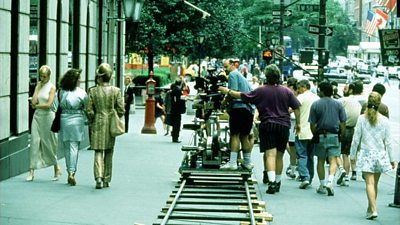
Contractors: Working with
This Guideline sets out our approach to working safely with contractors and includes access to our vetted contractor lists. -
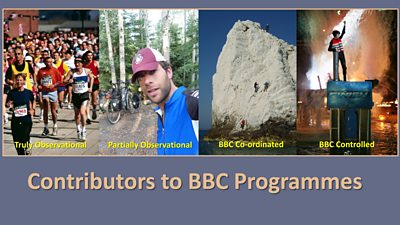
Contributors: Working with
This Safety Guideline provides guidance to those who work with contributors in the generation of content for our programmes or webpages, be it us filming / recording them or them providing us with their user generated content (UGC). -

Freelancers: Working with
A Safety Guideline to the engagement and management of ‘freelancers’ working at the �鶹��. -

Independent Production Companies: Working with
The �鶹�� needs to ensure that any Independent Production Company it commissions is able and competent to make the programme with due consideration for health and safety. -
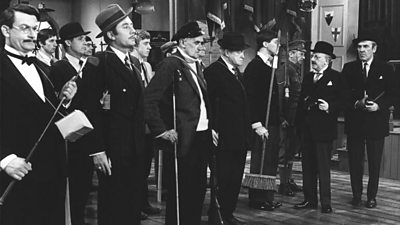
Monitoring and Review
Monitoring and review are the ‘check’ part of the Plan–Do–Check–Act of our H&S management system. -
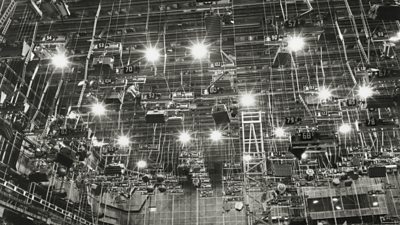
Riggers: Selection of
This Safety Guideline provides guidance to those who wish to engage riggers / rigging supervisors on productions. -
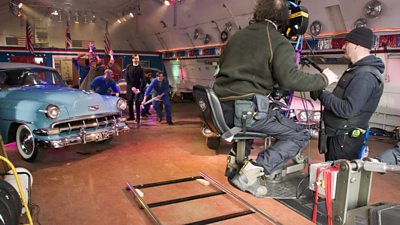
Working with Third Parties
This section lists the safety guidelines we have for when we work with third parties i.e. those who are not employed directly by the �鶹��.
More from SSR
-
Your platform to record accidents, risk assessments, assurance monitoring and inspections
-
Safety Equipment Stores
Just one number to call: 0844 800 8875 -
�鶹�� Safety Guidelines
An A-Z of �鶹��'s Health and Safety Guidelines -
Safety Advice Line: 0370 411 0464 Email: safety@bbc.co.uk
Events guidance - key links:
- Exhibitions
- General Guidance
- Indoor Location Recce Checklist
- Outdoor Location Recce Checklist
- Major Incidents & Emergency Planning
- Marketing and Promotional
- Noise Exposure
- Planning and Management
- Responsibilities
- Responsibilities Form
- Laser Lighting Effects
- Strobe Lighting
- Temporary Stages and Rostra
Health topics - key links:
- (�鶹�� network only)
- Contributors Fitness to Participate
- Display Screen Equipment (DSE)
- (�鶹�� network only)
- First Aid and Welfare on Location
- International Travel - Risks & Health
- Manual Handling
- Mental Health: Homepage
- (�鶹�� network only)
- Personal Health and Wellbeing
- Pregnancy
- Psychological Trauma Support & Trauma Risk Management (TRiM)
- Tiredness and Fatigue
- Travel Health Contacts
�鶹�� High Risk - key links:
- CBRN and Industrial Spills
- Covert Filming
- Crisis Management and Security Support
- Demonstrations, Protests and Crowds
- Disaster Coverage
- Door Stepping
- (�鶹�� network only)
- (�鶹�� network only)
- Public Order
- Safety Equipment Stores
�鶹�� Journalism - key links:
�鶹�� Productions - key links:
- Aerial Filming and Airfields
- Animals: Displaying and handling for performance
- Boats: Working on
- Children and Young People
- Driving
- Electrical Equipment and Systems
- First Aid and Welfare on Location
- Food Safety (Cooking and Catering)
- Remote Location Working
- Roads and Streets: Working by
- Security of Productions on Location
- Stunts
- Tiredness and Fatigue
- Unmanned Aerial Systems (UAS aka Drones)
- Vehicles: Recording in, from and around
- Working at Height: Mobile Elevating Work Platforms
- Working at Height: Tower Scaffolds
�鶹�� Radio - key links:
- (�鶹�� Network only)
�鶹�� Security - key links:
�鶹�� Sport - key links:
About this site
This site describes what the �鶹�� does in relation to managing its health, safety and security risks and is intended for those who work directly for the �鶹��.
It is not intended to provide instruction or guidance on how third parties should manage their risks. The �鶹�� cannot be held liable for how this information is interpreted or used by third parties, nor provide any assurance that adopting it would provide any measure of legal compliance. More information
Some links on this site are only accessible when connected to the �鶹�� network
